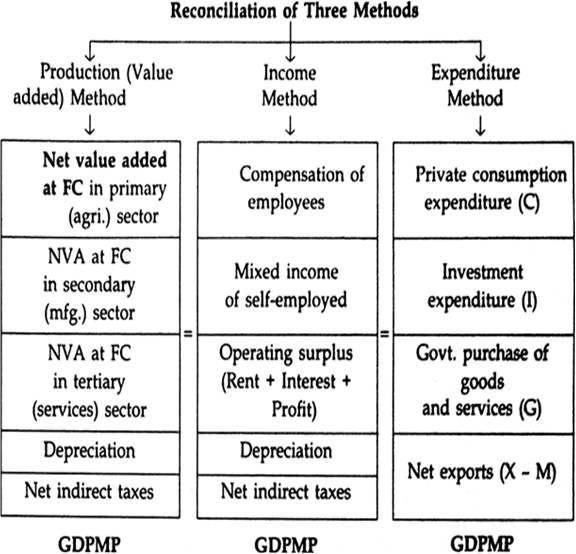Dear Aspirants,
This Spotlight is a part of our Mission Nikaalo Prelims-2023.
You can check the broad timetable of Nikaalo Prelims here
Session Details
YouTube LIVE with Parth sir – 1 PM – Prelims Spotlight Session
Evening 04 PM – Daily Mini Tests
Telegram LIVE with Sukanya ma’am – 06 PM – Current Affairs Session
Join our Official telegram channel for Study material and Daily Sessions Here
9th Mar 2023
National income, inclusive growth and other social sector related schemes
National Income
National income accounting refers to the set of methods and principles that are used by the government for measuring production and income, or in other words economic activity of a country in a given time period.
The various measures of determining national income are GDP (Gross Domestic Product), GNP (Gross National Product), and NNP (Net National Product) along with other measures such as personal income and disposable income.
National income accounting equation is an equation that shows the relationship between income and expense of an economy and other categories. It is represented by the following equation:
Y = C + I + G + (X – M)
Where
Y = National income
C = Personal consumption expenditure
I = Private investment
G = Government spending
X = Net exports
M = Imports
The most important metrics that are determined by national income accounting are GDP, GNP, NNP, disposable income, and personal income.
Methods of measuring National income

Issues associated with National Income accounting in India
(A) Problems in Income Method:
- Owner-occupied Houses
- Self-employed Persons
- Goods meant for Self-consumption
- Wages and Salaries paid in Kind
(B) Problems in Product Method:
- Services of Housewives
- Intermediate and Final Goods
- Second-hand Goods and Assets
- Illegal Activities
- Consumers’ Service
- Capital Gains
- Inventory Changes
- Depreciation
- Price Changes
(C) Problems in Expenditure Method:
- Government Services
- Transfer Payments
- Durable-use Consumers’ Goods
- Public Expenditure
Inclusive growth
- As per OECD (Organisation for Economic Co-operation and Development), inclusive growth is economic growth that is distributed fairly across society and creates opportunities for all.
- UNDP has described inclusive growth as “the process and the outcome where all groups of people have participated in growth and have benefited equitably from it”.
- It lessens the fast growth rate of poverty in a country and upsurges the participation of people into the development of the country.
Salient Features of Inclusive Growth
- Address the constraints of the excluded and marginalised.
- Participation from all sections of society
- Reduction in disparities among per capita incomes between different sectors and sections of society.
- Non – discriminatory
- Higher potential of poverty reduction
- Ensure access of people to basic infrastructure and basic services/capabilities such as basic health and education.
- Include poor, lagging socio – economic groups and lagging regions as well as they are partners in this growth.
Dimensions of Inclusive Growth
- Equality
- Good Governance
- Decentralization
- Accountability and Transparency
- Sustainability
- Financial Sustainability
- Social Sustainability
- Environment Sustainability
Social Sector related schemes
The list of schemes can be found here
https://www.civilsdaily.com/type/govt-schemes/
